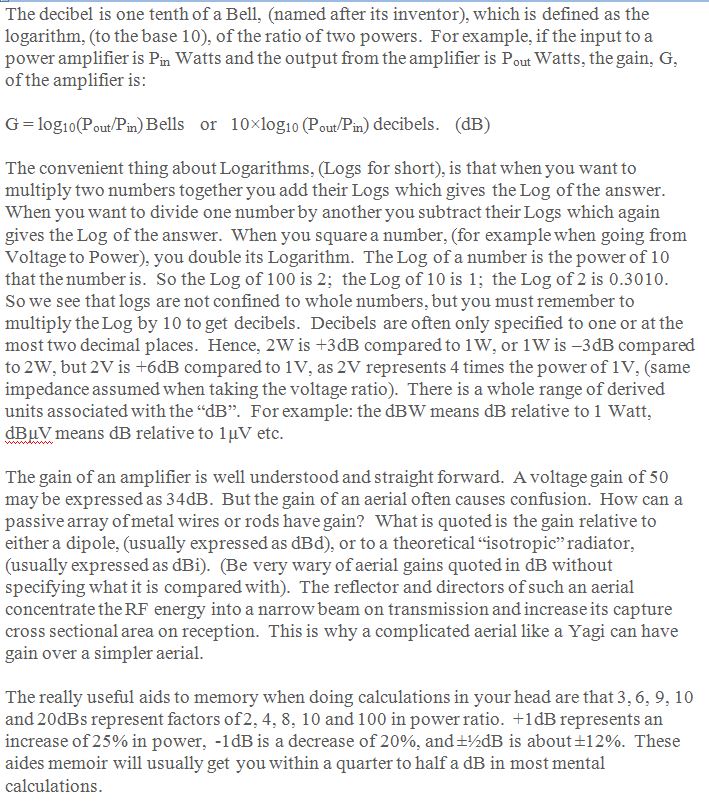| Back |
|---|
Most amateurs have heard of, and are moderately familiar with, dBs but some are still uncertain about why we use them or how to calculate them. For example if an amplifier has a gain of 50 times, why not say so? Why turn the figure into dBs? Or if a length of coax looses 90% of the RF power fed into it so that only 10% of the power comes out of the other end, why not say so instead of saying that it has a loss of 10dB? dBs are all about ratios; the input compared with the output. Amplifiers have gain, i.e. the output signal is usually bigger than the input. Most other devices like a length of coax cable have loss. So, before going on to discuss how to calculate dBs, it is worth considering the reasons for using them instead of doing calculations in actual units. There are three main reasons:
1) Using the “dB” compresses the enormous range of quantities which one often has to deal with in any branch of science, into manageable figures.
2) It provides a more meaningful expression for any change in a quantity.
3) It simplifies the arithmetic so that you can often do the sums “in your head”.
An example of the first reason is as follows: A receiver has a minimum discernable signal at its input of 0.1 µV and a blocking or “de-sense” level of 1Volt to signals in an adjacent band. Its input range could be expressed as 10,000,000 to 1 in voltage or 100,000,000,000,000 to 1 in power. Its range is expressed more concisely as 140dB.
An example of the second reason is: If you tell a receiving station that you were going to increase your transmitter power by 30 Watts, would he be impressed and would he notice? It depends on what power you were originally running. If you were running 370W he would scarcely notice the difference. If you were running 10W he would notice a whole “S-point” increase. It would be more meaningful to have said, “I am going to increase my power by 6dB”.
An example of the third reason is as follows: Consider the route which a voice signal has to take from a transmitter microphone to a distant receiver loud speaker. The microphone produces a few milli-volts of output. This is fed via a microphone amplifier with a certain gain, a modulator with some loss, an RF power amplifier with gain, a feeder with loss, to an aerial with some gain. The radio path from the transmitting aerial to the receiving aerial will have losses due to distance, houses, trees, hills, weather conditions etc. At the receiving end, the receiving antenna may have some gain, but the feeder will have loss, and the various receiver stages will have their own gains and losses. All these gains and losses will have to be appropriately multiplied or divided and applied to the microphone output to derive the power finally fed to the distant loudspeaker. Even if all these gains and losses were whole numbers, this would amount to a formidable sum. By expressing all the gains and losses in dBs, the sum is simplified to simple additions and subtractions which can be done “in your head”.
And now to calculate the decibel equivalent of any ratio. Unless you want to be super accurate, you won’t even need Log tables, provided you remember half a dozen easy to remember facts as shown later.

PRAECEPTOR
| Back |
|---|
